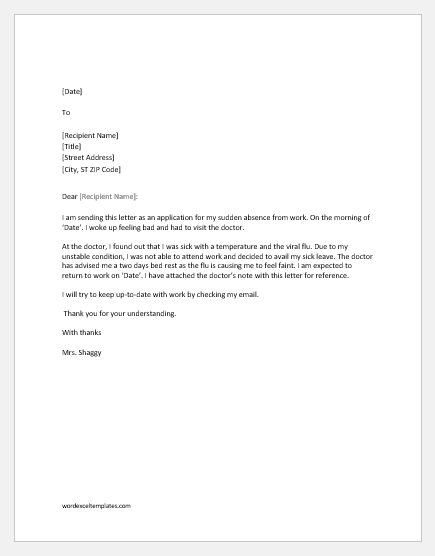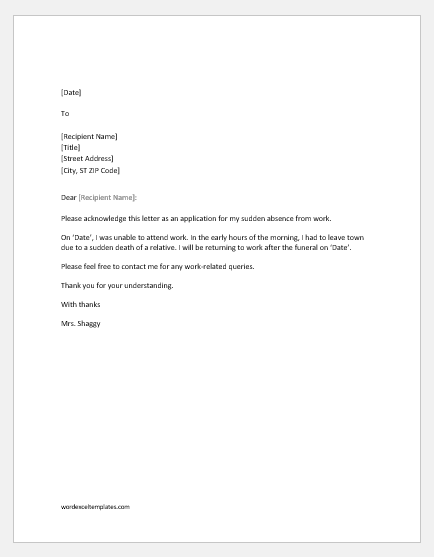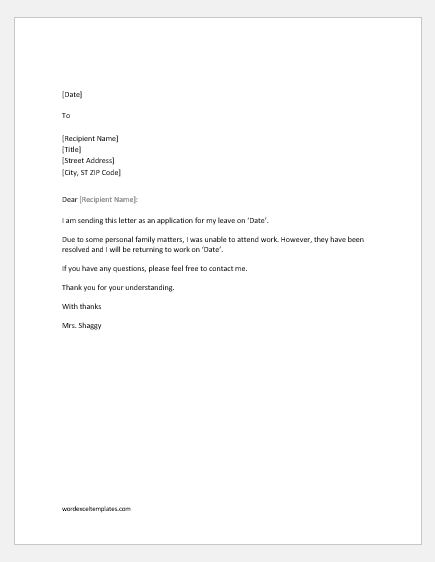When an employee takes unannounced leave from work, they must provide an excuse letter to their employer or the head of their respective department. This formal letter involves the employee informing their senior of their sudden absence from work and when they are expected to return.
Organizations allow different kinds of leave to their employees; however, the leave system may vary from organization to organization. Most organizations provide paid and sick leaves separately, and any other leaves from work are non-paid.
To avail of leave, the employees pre-plan their absence by informing their respective heads of the department or the Human Resources department through the provided leave application form or an email.
Why are excuse letters important?
Depending on the circumstances, the employee needs to inform their organization of their absence and the reason for the leave before or after taking it. This helps the employee keep a safe and formal relationship with their organization and also excuses them for missing work or being unreachable when needed.
Furthermore, the organization keeps a track record of the employees’ presence and work performance if an employee makes decisions that go against the organization’s policies, such as uninformed absences, the employee’s performance levels decrease, which might lead to the organization taking disciplinary action against the employee.
To whom and when do you send excuse letters?
Depending on the circumstances, the employee must inform their manager before their absence. If the employee plans on taking a day or a few off from work shortly, they need to send an email explaining why they need to take time off, when they will take the leave, the duration of the rest, and the date they are expected to return.
In some cases, such as emergencies, the employee must at least send a Text message or contact their manager by phone regarding their sudden absence. Later, it is recommended that the employee send a written email explaining their absence and when they are expected to return. This acts as proof that the employee sent a sudden leave application.
Different types of excuse letters
Employees may take leave for different reasons and different durations. Below are some examples of absence excuse letters:
Reason: Sickness
Dear ‘Name of Manager’,
I am sending this letter as an application for my sudden absence from work. On the morning of ‘Date’. I woke up feeling bad and had to visit the doctor.
At the doctor’s, I discovered I was sick with a temperature and the viral flu. Due to my unstable condition, I was not able to attend work and decided to take my sick leave. The doctor advised me to take two days of bed rest as the flu is causing me to feel faint. I am expected to return to work on ‘Date.’ I have attached the doctor’s note with this letter for reference.
I will try to keep up-to-date with work by checking my email.
Sincerely,
Name of Employee
Name of Department
Reason: Emergency
Dear ‘Name of Manager’,
Please acknowledge this letter as an application for my sudden absence from work.
On ‘Date,’ I was unable to attend work. In the early hours of the morning, I had to leave town due to a relative’s sudden death. I will return to work after the funeral on ‘Date.’
Please feel free to contact me with any work-related queries.
Sincerely,
Name of Employee
Name of Department
Reason: Personal
Dear ‘Name of Supervisor’,
I am sending this letter as an application for my leave on ‘Date.’
Due to some personal family matters, I was unable to attend work. However, they have been resolved, and I will return to work on ‘Date.’
If you have any questions, please feel free to contact me.
Sincerely,
Name of Employee
Name of Department
- Quarterly Tax Payment Tracker
- Baby Feeding Timer
- Payroll Tracker for Excel
- Allergy and Adverse Reactions Sheet
- Delivery Route Optimization Worksheet
- Energy Consumption Monitoring Worksheet
- Return on Investment (ROI) Calculator
- Investment Portfolio Tracker
- Equipment Utilization Worksheet
- Emissions Monitoring Worksheet
- Monthly Utility Consumption Worksheet
- Ramadan Schedule Notification for Staff
- Sales Tax Calculation Sheet
- Fixed Asset Register Template
- Advance Salary Tracker
- Benefits and Deductions Worksheet
- Capital Expenditure Tracker Template
- Departmental Budget Allocation Sheet



